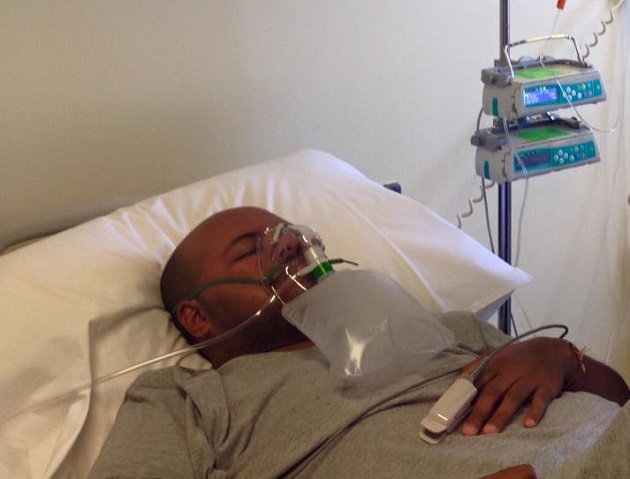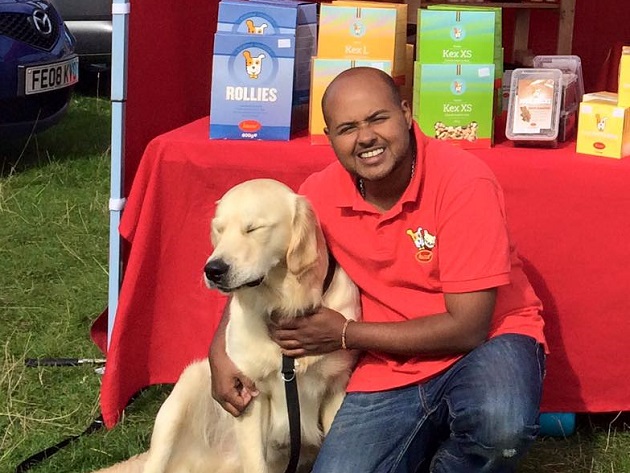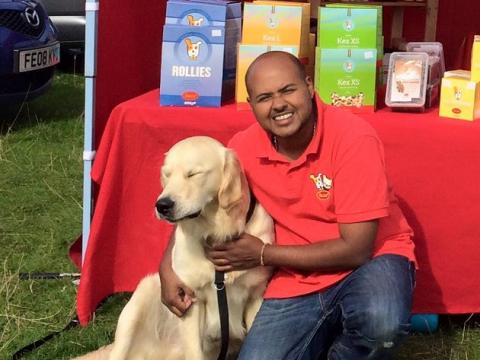In 2013, Nilush's acute myeloid leukaemia returned - and he was told he'd need a stem cell transplant to have any chance of life. After several adult donors dropped out at the last minute, he was told he'd need a cord blood transplant.
In today's blog, Nilush reflects on his experiences, and life after leukaemia.
I’d been feeling excessively tired for some time when I started noticing a few lumps around my ears and neck. I had a lack of appetite, too – and for me, that’s very unusual. (Constantly hungry.)
Work at that time was very intense – we were establishing new offices around the airport. I just couldn’t keep my eyes open; I couldn’t face anything and I didn’t feel like doing anything. I was describing my symptoms to a colleague, and she told me to get myself checked; she said, ‘That sounds a bit like leukaemia.’
I just didn’t have a clue. I didn’t really know what leukaemia was. So I did what any sensible person would do…I Googled it. The NHS site listed maybe 15 symptoms, and I had all of them, except for one. ‘An infection.’
‘I didn’t have an open wound or anything,’ I thought, before realising what they meant by ‘infection’. And yes, in fact, I did have a temperature.
So I went to my GP, and explained it all. She had a good laugh at me, because I’d Googled everything, but she organised an emergency blood test for me all the same.
My leukaemia diagnosis
That same night, at about 10 or 11, I had a call from the Leicester Royal Hospital; they needed to run some more tests, so I’d have to stay over.
The registrar explained that the blood test indicated leukaemia, so I’d need a bone marrow biopsy and more tests the following day. That confirmed it – acute myeloid leukaemia.
The consultant told me, ‘I can’t let you go home. We need to put you on chemotherapy right away – if not, I give you a week.’
I was in the hospital for eight months, undergoing three cycles of chemo, I did have a lot of infections, and various complications before I found myself in full remission.
Sadly, it didn’t last. Shortly afterwards, I joined a trial to test some new drugs, but the trial found that the leukaemia was returning; I was about to relapse.

The search for my stem cell donor
They’d already tested my brother to see if he was a match for me (he wasn’t), so now the hunt was on for an unrelated donor, to provide me with a stem cell transplant.
More than once, my doctors told me that they’d found me a perfect match. But then the donation fell through, again and again.
Next they tried to give me an autologous transplant, taking my own stem cells and repairing them, then returning them to me. But that didn’t work either; my body just wasn’t producing enough stem cells.
So my last option was a cord transplant.
And finally, after six months of searching, Anthony Nolan let me know that they’d found me two cords (since one cord wouldn’t have contained enough stem cells); one from Australia, and one from America.
My cord blood transplant
The transplant took place in November 2013; it was very smooth and was done in no time, (And I’m still here!)
I did perhaps have six months of feeling sick from Graft versus Host Disease, but after that it settled down. And I began to get used to the ‘new normal’.
Through it all, I always listened to my medical team. At the very beginning, my consultant said, ‘When it comes to your treatment plan, you only have to do one thing. You have to trust me.’
So I did. I went through various procedures, I had to have various drugs, emergency surgery, blood taken every day, rushed to have various tests. At times it was all a bit too much and I didn’t always want to go through with it, but I did.
And I didn’t worry too much about the illness itself, either. I knew my medical team were doing everything they could.
My emotional wellbeing
When you’re going through this, you’re probably thinking, ‘Why me? Why has this happened?’
That’s when your mind starts to play tricks on you. I think it’s better to somehow find the strength to just accept what’s happened to you, and try to fight back. You are stronger than you think!
I tackled it all with a good sense of humour; that’s me and how I deal with things. So I was able to laugh at everything, too. It kept my spirits up.
But through everything, I had the support of a wonderful medical team. In the end, they become like friends and family, because you’re in the hospital for so long.
Then there was my partner, Helen. I wouldn’t have got this far without her.
It’s a very big thing, the strength that Helen gave me.
In many ways, it was harder for her than for me. Some days, I just wasn’t conscious for very long, and was just lying in a hospital bed connected to an IV. But Helen came in anyway, and cared for me. So she had to experience every moment of it, along with my mum, dad and my brother. Every week my brother had to taxi my parents from London to Leicester and back.
Their love and support is what got me through this. And it’s very important to have that kind of support to pull you through something bad as this.

Life after transplant
I didn’t want to go back to my old job; a corporate role, office work. Honestly, it was mostly because I thought I’d be a liability to an employer, with all of the time I’d taken off work during my illness and the limitations it left me with.
Instead I wanted to do something for myself.
So I was looking at small businesses for inspiration, and that’s when I came across a Swedish pet food franchise. That was it, I decided; that was what I wanted to do. So I became a pet nutritionist.
It’s really exciting because you get to meet new people, it challenges my brain and strength and the main thing is that it’s really rewarding; helping pet owners with their pet’s wellbeing. There’s obviously a bit of stress at times (financial!) but it’s really worth it, too.
Also, I get to meet a lot of cats and dogs. I find that really soothing – I’m an animal person.
Being able to choose my working hours also lets me carry on with volunteering, raising awareness about leukaemia, and encouraging people to join the bone marrow register – especially Sri Lankans.
And being part of the Anthony Nolan Patient and Family Panel, and attending their patient education days, helps to give you that extra support you need to get on with your new normal life.
By being able to learn more about how to deal with and overcome the illness itself and what it has left behind, supporting families who are on this journey, and sharing your experience and story with others, it makes you feel like you are part of a team and not alone (a VIP member of Club Leukaemia!).
So life is good.
And finally…
I would like to thank the team at Anthony Nolan, and the team at Leicester Royal. If it wasn’t for all these people, I don’t think I’d be here. I’m a rich man, in terms of everyone I’ve met along this journey.
If you have found this blog in any way interesting , and you’re thinking about signing up as a stem cell donor – please, take the commitment seriously. This is sometimes the only lifeline a person with blood cancer can be given, so don’t just sign up for the sake of doing it.
It is a commitment, but a very rewarding commitment. You’ll get to save someone’s life, and it doesn’t get any cooler than that!
To find out more about adjusting to life after transplant, and emotional wellbeing during your recovery, download one of our Anthony Nolan patient information booklets (also available in hard copy).
